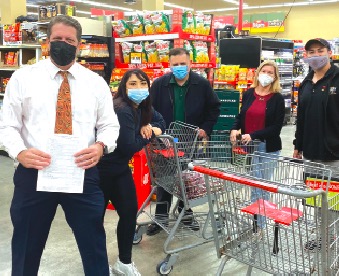 _______________________________
_______________________________
 __________________________________
__________________________________
 “In towns and cities... there is no more important institution than the local paper.”
Warren Buffett
“In towns and cities... there is no more important institution than the local paper.”
Warren Buffett

LA MIRADA COUNCILMAN John Lewis (l) with with Rotarians and Grocery Outlet owners Steve and Amanda Hernandez.
By Tammye McDuff
Nearly one million Los Angeles County residents are still struggling, according to a new by USC Dornsife’s Public Exchange.
Food insecurity continues at pre-pandemic levels, with more than one in ten Angelenos still fraught with financial uncertainty.
Research found that adults who remained food insecure in the first two quarters of 2021 were low income women, Latinos and people between the ages of 18 and 40 years of age.
This came from the Public Exchange at the USC Dornsife College of Letters, Arts and Sciences that analyzed the impact of COVID-19 on food insecurity.
Just one in four food-insecure households was receiving food assistance benefits as of June 2021.
More than a third of them live in “food deserts” — low-income areas with poor access to supermarkets and large grocery stores.
An Associated Press review of bulk distribution numbers from hundreds of food banks across the country revealed a clear downward trend in the amount of food handed out across the country.
That started in the spring of 2021 as the COVID-19 vaccine rollout took hold and closed sectors of the economy began to reopen.
“It’s come down, but it’s still incredibly high,” said Katie Fitzgerald, COO of Feeding America, a nonprofit organization that coordinates the efforts of more than 200 food banks across the country.
Fitzgerald stated that despite the decrease, the amount of food being distributed by Feeding America’s partner food banks remained more than 55% above pre-pandemic levels.
“We’re worried (food insecurity) could increase all over again,” she added.
Feeding America projects that 42 million people including 13 million children, will experience food insecurity this year.
Many people who have been most impacted by the pandemic were food insecure or at risk of food insecurity before COVID-19 and are facing greater hardship since COVID-19.
Many cities are continuing to host food distribution events.